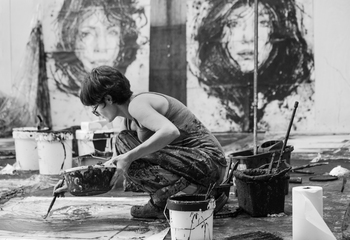
Artist Focus: Lídia Masllorens
The presence of the portraits by Catalan artist Lídia Masllorens lies in the power of black paint and their extraordinary dimensions. Painted in several stages on the floor on sheets of paper that she then assembles, they impress with their often intense gaze and archetypal beauty. The portraits are painted in black acrylic on paper, a process of colour removal, using water and bleach, and not superimposition, thus using a subtractive, rather than additive, technique. This technique allows for the beautiful colour palette that distinguishes her work; with shades from pink to white and black to grey. A graduate in Fine Arts from the University of Barcelona in 1991, Lídia Masllorens exhibits regularly in Spain and has also specialized in photography, sculpture and engraving. In recent years, her portraits have toured the world, notably at the Sorbonne Catalan Art Centre in Paris, the Osaka Contemporary Art Centre in Japan, but also in galleries in Cologne, Antwerp, Barcelona and Paris, and have met with resounding success.
When she evokes her inspirations, Lídia says she finds them in art: "You might think that my inspiration is fashion photography, but photography is just a tool, like brushes, black color, or using large formats. My real inspiration is the work of other artists, the likes of Botticelli, Picasso, Warhol, Barceló, Dumas, Peyton... or any other contemporary artist you can find in an art exhibition or art fair."
In the creative process, the artist is most interested in the way a painting is worked: "I work indirectly: horizontally, on the floor on a large plastic sheet... the result is a unique imprint on the paper. I need the large format to be almost more physical than mental work, in which chance and surprise are very important. I am looking for an approximate figuration, to suggest rather than to tell. Faces are an excuse for this formal work. For me, the concept appears by itself when the painting has a mirror effect on the viewer."
